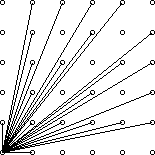Visible Lattice Points
| Time Limit: 1000MS | Memory Limit: 65536K | |
| Total Submissions: 8438 | Accepted: 5173 |
Description
A lattice point (x, y) in the first quadrant (x and y are integers greater than or equal to 0), other than the origin, is visible from the origin if the line from (0, 0) to (x, y) does not pass through any other lattice point. For example, the point (4, 2) is not visible since the line from the origin passes through (2, 1). The figure below shows the points (x, y) with 0 ≤ x, y ≤ 5 with lines from the origin to the visible points.

Write a program which, given a value for the size, N, computes the number of visible points (x, y) with 0 ≤ x, y ≤ N.
Input
The first line of input contains a single integer C (1 ≤ C ≤ 1000) which is the number of datasets that follow.
Each dataset consists of a single line of input containing a single integer N (1 ≤ N ≤ 1000), which is the size.
Output
For each dataset, there is to be one line of output consisting of: the dataset number starting at 1, a single space, the size, a single space and the number of visible points for that size.
Sample Input
4 2 4 5 231
Sample Output
1 2 5 2 4 13 3 5 21 4 231 32549
Source
思路:对于n*n,可以从 (0,0)连接到(n,0)到 (n,n)上,斜率将会是1/n,2/n~(n-1)/n,凡是分子分母能够约分的,也就是有公约数,前面已经有过了,所以每次添加的个数就是分子分母互质的个数。那么问题,就转化为一数小于n的与n互质的数的个数,这就是欧拉函数。
PS:这规律谁能发现啊!!1
欧拉线性筛选:模板
#include<cstdio>
#include<string>
#include<cstring>
using namespace std;
const int maxn=1008;
int phi[maxn],prime[maxn],tot=0;
int mark[maxn];
void getph()//欧拉线性筛选
{
memset(mark,0,sizeof(mark));
phi[1]=1;
for(int i=2;i<=maxn;i++)
{
if(!mark[i])
{
prime[++tot]=i;
phi[i]=i-1;
}
for(int j=1;j<=tot;j++)
{
if(i*prime[j]>maxn) break;
mark[i*prime[j]]=1;
if(i%prime[j]==0)
{
phi[i*prime[j]]=prime[j]*phi[i];
break;
}
else
{
phi[i*prime[j]]=phi[i]*(prime[j]-1);
}
}
}
}
int main()
{
int t,time=0;
getph();
scanf("%d",&t);
while(t--)
{
time++;
int n,ans=0;
scanf("%d",&n);
for(int i=1;i<=n;i++)
{
ans+=phi[i];
}
printf("%d %d %d \n",time,n,ans*2+1);
}
return 0;
}
 可见格点计数与欧拉函数
可见格点计数与欧拉函数





















 255
255

 被折叠的 条评论
为什么被折叠?
被折叠的 条评论
为什么被折叠?










